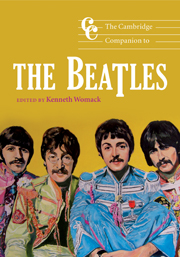Book contents
- Frontmatter
- Introducing the Beatles
- Part I Background
- Part II Works
- 3 Rock and roll music
- 4 “Try thinking more”: Rubber Soul and the Beatles' transformation of pop
- 5 Magical mystery tours, and other trips: yellow submarines, newspaper taxis, and the Beatles' psychedelic years
- 6 Revolution
- 7 On their way home: the Beatles in 1969 and 1970
- 8 Apple Records
- 9 The solo years
- 10 Any time at all: the Beatles' free phrase rhythms
- Part III History and influence
- Notes
- Beatles discography, 1962–1970
- Select bibliography
- Index
7 - On their way home: the Beatles in 1969 and 1970
from Part II - Works
Published online by Cambridge University Press: 28 September 2011
- Frontmatter
- Introducing the Beatles
- Part I Background
- Part II Works
- 3 Rock and roll music
- 4 “Try thinking more”: Rubber Soul and the Beatles' transformation of pop
- 5 Magical mystery tours, and other trips: yellow submarines, newspaper taxis, and the Beatles' psychedelic years
- 6 Revolution
- 7 On their way home: the Beatles in 1969 and 1970
- 8 Apple Records
- 9 The solo years
- 10 Any time at all: the Beatles' free phrase rhythms
- Part III History and influence
- Notes
- Beatles discography, 1962–1970
- Select bibliography
- Index
Summary
Given the high amount of magnificent music the Beatles recorded in 1969, it may surprise millions of casual listeners to learn that aside from a few numbers, all of the official tracks from the band's last full year – including classics such as “Let It Be,” “Get Back,” “The Long and Winding Road,” “Come Together,” “Across the Universe,” “Something,” “Don't Let Me Down,” and the medley on side two of Abbey Road – were created to the tune of four once inseparable friends going through an ugly divorce. Most of the tracks belie sessions where egos were so wounded by the slightest offense, whether real or imagined, that only in patches did the Fab Four function with a unified vision and in a collaborative spirit. Abbey Road and Let It Be, along with “The Ballad of John and Yoko” and three B sides, were made amid spats, sulks, shouting matches, temporary alliances, simmering jealousies, and many sessions with one or more of the Beatles absent. “Given these circumstances,” writes Walter Everett, “it is somewhat remarkable that Abbey Road is universally recognized as a coherent demonstration of inspired composition, impeccable vocal and instrumental ensemble, and clean and cleverly colorful engineering.” And while Let It Be may not possess the polish of Abbey Road, many listeners prefer it for that very reason. Shining through the ramshackle and at times poorly performed and indifferently recorded pieces are melodies, harmonies, and grooves as addictive as any in the Beatles' canon.
- Type
- Chapter
- Information
- The Cambridge Companion to the Beatles , pp. 125 - 141Publisher: Cambridge University PressPrint publication year: 2009

